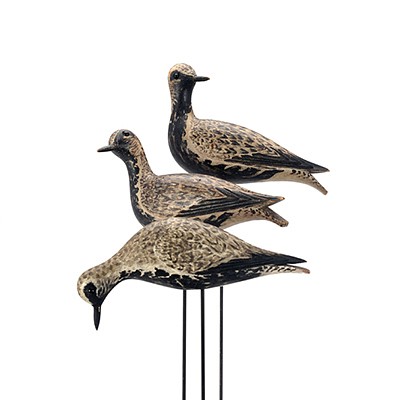Great Blue Heron Decoy
About Seller
20 Winter Street
Pembroke, MA 02359
United States
Founded in 2005, Copley Fine Art Auctions is a boutique auction house specializing in antique decoys and American, sporting, and wildlife paintings. Over the course of the last two decades, the firm has set auction records for not only individual decoy makers, but also entire carving regions. Copley...Read more
Two ways to bid:
- Leave a max absentee bid and the platform will bid on your behalf up to your maximum bid during the live auction.
- Bid live during the auction and your bids will be submitted real-time to the auctioneer.
Bid Increments
| Price | Bid Increment |
|---|---|
| $0 | $50 |
| $1,000 | $100 |
| $2,500 | $250 |
| $5,000 | $500 |
| $10,000 | $1,000 |
| $25,000 | $2,500 |
| $50,000 | $5,000 |
About Auction
Jul 9, 2021
Lots 1-246 Copley Fine Art Auctions cinnie@copleyart.com
- Lot Description
Great Blue Heron
New England, c. 1900
40 1/2 in. long, 40 in. tall on base
"When well conceived and endowed with the awkward grace of the great bird itself, a heron decoy can take command of almost any collection. Their variety runs the entire gamut from the most primitive forms to beautifully carved and painted examples.? ? William J. Mackey Jr., "American Bird Decoys"
True working heron decoys are difficult to obtain, with surviving decoys by known makers nearly non-existent. Heron carvings were often used as confidence decoys for other species and lore has it that some of the old baymen collected them as tablefare. These waders were additionally hunted for their plumage until they received full legal protection under the Migratory Bird Treaty Act of 1918.
Herons' use as confidence decoys was not adopted in most areas and most makers never added one to their rigs. This grand carving measures over forty inches from tip to tail and has a circumference of over thirty-one inches. Similar to the geese of Charles Safford and John Tax, the large hollow body was made with multi-piece construction. Unlike a Safford, it is hollow and has numerous wood patches, mostly around the end grain. The head is turned and slightly cocked, and features its original wooden crest. Complementing the high head is a long flowing tail, which has been hollowed out from below.
The underside has two original rectangular holes for legs which reach into the hollow cavity. It fits securely on a custom Aarne Anton black steel base and stands at a total height of forty inches.
One related example is held in a private New England collection.
Mix of old paint with heavy wear and working repairs. A single modern fastener has been added to secure the head. Some scattered touch-up.
Provenance: Private Collection, New England
The Johnson Collection
Literature: William J. Mackey Jr., "American Bird Decoys," New York, NY, 1965, Chapter IV, herons discussed and illustrated.Please email condition report requests to colin@copleyart.com. Any condition statement given is a courtesy to customers, Copley will not be held responsible for any errors or omissions. The absence of a condition statement does not imply that the lot is in perfect condition.Condition
- Shipping Info
-
Copley Fine Art Auctions does not handle the shipping of any items. Shipping is the sole responsibility of the buyer. Once your payment has cleared, and we have received your authorized shipping release form items may be released for shipment. Copley Fine Art Auctions, LLC shall have no liability for any loss or damage to such items. Buyers should allow up to four weeks for shipment. Please be aware that internet bidders may NOT not pick up their items at the sale. Items will be available for pick up by appointment or by shippers five days after the sale.
-
- Buyer's Premium



 EUR
EUR CAD
CAD AUD
AUD GBP
GBP MXN
MXN HKD
HKD CNY
CNY MYR
MYR SEK
SEK SGD
SGD CHF
CHF THB
THB















